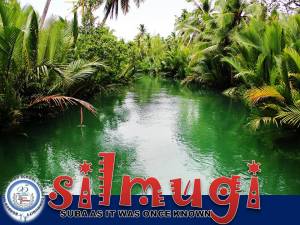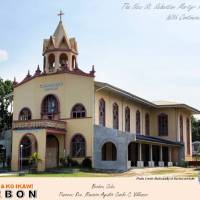Long before Silmugi laid claim as the official name of the captivating river pouring out from Ylaya spring and other upland water sources, it was once renowned for its common repute as ‘Suba’. Old folks and children alike speak of this river in common accord. That when local residents wish to have a grab of fresh catch from fisher folks living the river side, people would just refer them as saying, “Adto sa Suba, para makapalit ka ug lab-as nga isda!”
The name ‘Suba’ may get more familiar in times and Silmugi, as it is now officially claimed, eventually elapsed in the passing of time, rooting it way-way back. That is why some generations in Borbon may find it new-fangled when the name Silmugi is being referred to this waterway, rather than the proverbial Suba.
With the extensive research by our local government unit to map out the remnant of times, Silmugi as it was widely recognized by the whole of Borbon during olden times (Spanish era, Japanese occupation and American regime) has reclaim its original name.
It is good to note though that young generation can now refer this enchanting river to its unfeigned name SILMUGI.
We don’t insinuate the name ‘Suba’ to confuse everyone but for us Borbonanon to remember that in the annals of history of our beloved town, Silmugi River was once called by local folks as merely Suba only and not Silmugi. We, the young generation of Borbon, understand the common word based on what was passed on by our forefather wherein the term became a common lingo eventually.
Not knowing that by definition, Suba is just a Spanish copula (meaning river) which has become a part of the young Borbonanon lexicon. We don’t even know the word Silmugi until it was introduced to us by our LGU and of course with the more profound celebration of Silmugi Festival.
Here’s why Suba before is more familiar than Silmugi:
•Asa mo bay? Mamasol mi sa Suba! (Where are you going? We will go fishing in Suba!)
•Ligo ta? Adto lang ta sa Suba para maka-ambak ta sa taytayan! (Let’s go swimming? Okay, let’s try Suba so we can jump over the bridge!)
•Manguha ta ug nipa? Adto sa Suba kay daghan kaayong dahon ang mga nipa didto? (Let’s gather some nipa leaves? We’ll go to Suba as nipa leaves there are more abundant!)
•Ngadto ta sa tabigi, mag baruto lang ta? Segi, adto ta agi sa Suba! (Let’s head to the spring and take a boat ride? Okay, then we’ll take the route from Suba!)
•Tan-aw ngadto’g lab-as nga isda dong? Segi Ma, adto ko sa Suba, basin ug naa nay dunggo karon! (Can you check some fresh seafood? Okay mother, I’ll go to Suba maybe some fishermen are docking already with their fresh catch!)
•Nak, ilunang to atong kabaw? Segi tay, akong dad-on sa Suba kay hapit sad ko ug kaligo! (Child can you take our carabao to the swamp? Okay father, I’ll take the carabao to Suba as I want to go for a dip too!)
Anyway, what’s more prominent than the fact that Borbon has increasingly attracting more visitors & sightseers. The town’s festival was officially formed, environmental landscape has changed & even aesthetic places were eventually developed.
Borbon is even more recognized with historical landmarks, beautiful beaches, remarkable caves and of course, astounding and friendly people.
What more can we ask for?
Alumni react!






